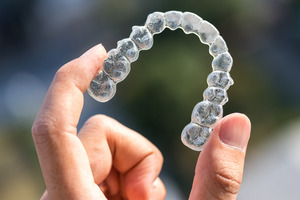
The aligners used for your Invisalign treatment are each designed to fit snugly over your teeth. Sometimes, though, you may try to put in an aligner only to discover that it doesn’t seem to fit like it should. What can you do to make sure that this problem doesn’t disrupt your treatment? Below is a quick look at 3 reasons why your Invisalign aligners may not fit and what you can do to solve the issue.
1. You Just Switched to a New Aligner
Sometimes the issue may simply be the fact that you have just started wearing the aligner in question. The idea behind Invisalign aligners is that they move your teeth to new positions. But since your teeth have not yet reached the intended positions, a new aligner may feel tight at first.
Fortunately, oftentimes you can solve this issue on your own with soft cylinders known as Invisalign chewies. Biting down on these chewies for a certain amount of time will put a small amount of pressure on your aligners, which can ultimately help them stay in place on your teeth.
2. You Didn’t Wear Your Previous Aligner as Much as You Should Have
Each aligner gradually moves your teeth closer to their ideal positions. However, it’s important for your aligners to stay in your mouth for at least 20 to 22 hours every day. If you don’t wear them enough, the teeth won’t move the way they’re supposed to; consequently, the next set of aligners may not fit correctly by the time you make the switch.
In this situation, you should schedule a consultation with your dentist to see what they recommend. In many cases, the solution may be as simple as wearing your previous aligners until the proper changes have been made.
3. There Is Something Wrong with the Aligner Itself
Sometimes the problem may lie in the actual aligner. It could simply be that it was made improperly, but there’s also a chance that it could have been damaged in some way. For example, if you expose your aligner to hot water, it can become warped, thus preventing it from fitting correctly on your teeth.
Naturally, if you believe your aligner has been damaged, your best option is to contact your dentist right away to see how they recommend dealing with the situation. If need be, they can have a new aligner made.
An ill-fitting aligner can be an obstacle on your path to a straighter smile, but fortunately, it’s a problem that often has an answer. Remember that you always have the option of getting in touch with your dentist if you have any concerns about your Invisalign treatment.
About the Author
Dr. Dustin C. Lively went to the University of Oklahoma College of Dentistry, and he has completed continuing education courses at the Misch Implant Institute as well as the Pierre Fauchard Academy. He has helped many patients achieve straighter smiles thanks to Invisalign. To schedule a consultation with Dr. Lively at 333 Dental Care in Mangum, visit his website or call (580) 782-2552.

